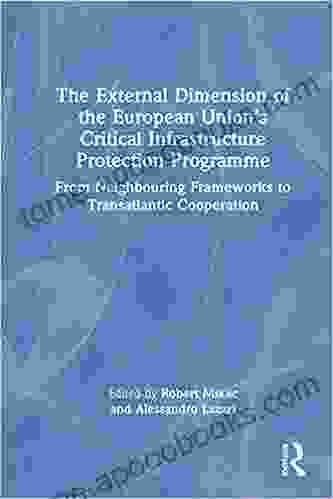From Neighboring Frameworks to Transatlantic Cooperation: A Comprehensive Guide

5 out of 5
| Language | : | English |
| File size | : | 5712 KB |
| Text-to-Speech | : | Enabled |
| Enhanced typesetting | : | Enabled |
| Word Wise | : | Enabled |
| Print length | : | 336 pages |
| Screen Reader | : | Supported |
In today's interconnected world, collaboration and cooperation among nations are essential for addressing global challenges and promoting stability. Transatlantic cooperation, specifically between the European Union (EU) and the United States, has played a pivotal role in shaping international relations and global affairs. This comprehensive guide delves into the evolution of neighboring frameworks, exploring their contributions to the development of transatlantic cooperation and its significance in contemporary international relations.
Neighboring Frameworks: A Foundation for Cooperation
Neighboring frameworks have served as the cornerstone of transatlantic cooperation, facilitating dialogue, coordination, and collaboration between the EU and the US. These frameworks have evolved over time, reflecting the changing dynamics of international relations and the growing interconnectedness of the global community.
The North Atlantic Treaty Organization (NATO)
Established in 1949, NATO is a military alliance of 30 North American and European countries. Its primary objective is to guarantee the collective security of its members through political and military means. NATO has played a crucial role in maintaining stability in Europe, particularly during the Cold War. It continues to be a cornerstone of transatlantic cooperation, providing a platform for consultation and coordination on security matters.
The Organization for Security and Co-operation in Europe (OSCE)
The OSCE is a security-oriented intergovernmental organization with 57 participating states from Europe, North America, and Central Asia. It aims to promote dialogue and cooperation on security issues, including conflict prevention, arms control, and human rights. The OSCE has been instrumental in fostering stability and cooperation in the post-Cold War era, contributing to the development of transatlantic cooperation.
The Council of Europe
The Council of Europe is an international organization dedicated to promoting human rights, democracy, and the rule of law. It was established in 1949 and has 47 member states. The Council of Europe has played a significant role in shaping European values and standards, contributing to the convergence of legal and political systems within the region. It has also served as a platform for dialogue and cooperation between the EU and non-EU member states.
The Evolution of Transatlantic Cooperation
Transatlantic cooperation has evolved significantly since the end of World War II. Initially focused on security and economic recovery, it has expanded to encompass a wide range of issues, including trade, climate change, energy security, and global governance.
The establishment of the European Coal and Steel Community (ECSC) in 1951 marked the beginning of formal economic cooperation between European countries. The ECSC later evolved into the European Union, which has become a major economic and political power in its own right. The EU has played a central role in shaping transatlantic cooperation, particularly in areas such as trade and climate change.
The end of the Cold War in 1991 opened up new possibilities for transatlantic cooperation. With the threat of Soviet expansionism diminished, the US and EU were able to focus on common challenges and opportunities. The expansion of NATO and the EU eastward has further strengthened transatlantic ties, creating a zone of stability and prosperity across Europe.
Contemporary Significance of Transatlantic Cooperation
In the 21st century, transatlantic cooperation remains essential for addressing global challenges and promoting stability. The US and EU share common values and interests, including democracy, human rights, and free trade. They also face common threats, such as terrorism, climate change, and cyber threats.
Transatlantic cooperation is vital for maintaining international peace and security. NATO continues to play a key role in deterring aggression and promoting stability in Europe. The US and EU also work together to address global security challenges, such as terrorism and non-proliferation.
In addition to security, transatlantic cooperation is crucial for promoting economic growth and prosperity. The US and EU are each other's largest trading partners, and their combined economic weight gives them significant influence in global economic affairs. Cooperation on trade and investment helps to create jobs, boost innovation, and promote sustainable economic development.
Transatlantic cooperation is also essential for addressing global issues such as climate change, energy security, and migration. The US and EU share common goals in these areas, and they can work together to develop effective solutions. Cooperation on climate change, for example, is vital for mitigating its effects and transitioning to a clean energy future.
The evolution of neighboring frameworks has laid the foundation for strong transatlantic cooperation, which has been a cornerstone of international relations for decades. From the establishment of NATO and the EU to the expansion of the OSCE and the Council of Europe, these frameworks have facilitated dialogue, coordination, and collaboration between the US and EU. Today, transatlantic cooperation remains essential for addressing global challenges, promoting stability, and advancing common interests. By working together, the US and EU can continue to shape the future of international relations and create a more prosperous and secure world for all.
5 out of 5
| Language | : | English |
| File size | : | 5712 KB |
| Text-to-Speech | : | Enabled |
| Enhanced typesetting | : | Enabled |
| Word Wise | : | Enabled |
| Print length | : | 336 pages |
| Screen Reader | : | Supported |
Do you want to contribute by writing guest posts on this blog?
Please contact us and send us a resume of previous articles that you have written.
 Book
Book Novel
Novel Page
Page Chapter
Chapter Text
Text Story
Story Genre
Genre Reader
Reader Library
Library Paperback
Paperback E-book
E-book Magazine
Magazine Newspaper
Newspaper Paragraph
Paragraph Sentence
Sentence Bookmark
Bookmark Shelf
Shelf Glossary
Glossary Bibliography
Bibliography Foreword
Foreword Preface
Preface Synopsis
Synopsis Annotation
Annotation Footnote
Footnote Manuscript
Manuscript Scroll
Scroll Codex
Codex Tome
Tome Bestseller
Bestseller Classics
Classics Library card
Library card Narrative
Narrative Biography
Biography Autobiography
Autobiography Memoir
Memoir Reference
Reference Encyclopedia
Encyclopedia Ayan Sharma
Ayan Sharma Anthony Williams
Anthony Williams Dominic Mchugh
Dominic Mchugh Ashley Hutson
Ashley Hutson Matthew Howard
Matthew Howard Valerie Lloyd
Valerie Lloyd Ava Lennart
Ava Lennart Antoine Laurain
Antoine Laurain Antonia Salomon
Antonia Salomon Arthur Sullivan
Arthur Sullivan April Green
April Green April Terhaar
April Terhaar Louise Crowther
Louise Crowther Arthur Schopenhauer
Arthur Schopenhauer Susan Berry Casey
Susan Berry Casey Lindsay Nelson
Lindsay Nelson Asian Development Bank
Asian Development Bank Asia Monique
Asia Monique Anthony Dalton
Anthony Dalton Autumn Summers
Autumn Summers
Light bulbAdvertise smarter! Our strategic ad space ensures maximum exposure. Reserve your spot today!

 Herman MitchellAdvanced Paper Airplanes: Unleash Your Inner Aviator and Conquer the Skies
Herman MitchellAdvanced Paper Airplanes: Unleash Your Inner Aviator and Conquer the Skies
 Henry David ThoreauImperialist Ideology in the Disney Comic: Unraveling the Colonialist...
Henry David ThoreauImperialist Ideology in the Disney Comic: Unraveling the Colonialist... Charlie ScottFollow ·3.1k
Charlie ScottFollow ·3.1k Xavier BellFollow ·10k
Xavier BellFollow ·10k Leo TolstoyFollow ·13.5k
Leo TolstoyFollow ·13.5k Arthur Conan DoyleFollow ·12.7k
Arthur Conan DoyleFollow ·12.7k Jake PowellFollow ·17.3k
Jake PowellFollow ·17.3k Dallas TurnerFollow ·3.7k
Dallas TurnerFollow ·3.7k Thomas HardyFollow ·19k
Thomas HardyFollow ·19k Javier BellFollow ·17.2k
Javier BellFollow ·17.2k

 Gabriel Garcia Marquez
Gabriel Garcia MarquezLad Dog Baby Professor: The Perfect Book for Your Child
Lad Dog Baby...

 Fredrick Cox
Fredrick CoxAn Excerpt With Fifty Ways To Help Animals Promo Books:...
: Embracing Animal...

 Kelly Blair
Kelly Blair5th Grade US History: Famous US Authors: Fifth Grade...
Step into a captivating world of historical...

 Natsume Sōseki
Natsume SōsekiKull the Destroyer: A Timeless Tale of Sword and Sorcery
The Creation of a...

 Jim Cox
Jim CoxDas Ist Supertoll: Unlocking the Magic of German for Kids
Immersive Learning with...

 Bruce Snyder
Bruce SnyderUnlock the World of Quilting for Kids: Discover "Quick...
Are you ready to embark on a delightful...
5 out of 5
| Language | : | English |
| File size | : | 5712 KB |
| Text-to-Speech | : | Enabled |
| Enhanced typesetting | : | Enabled |
| Word Wise | : | Enabled |
| Print length | : | 336 pages |
| Screen Reader | : | Supported |








